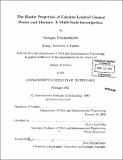| dc.contributor.advisor | Franz-Josef Ulm. | en_US |
| dc.contributor.author | Constantinides, Georgios, 1978- | en_US |
| dc.contributor.other | Massachusetts Institute of Technology. Dept. of Civil and Environmental Engineering. | en_US |
| dc.date.accessioned | 2011-08-01T14:34:08Z | |
| dc.date.available | 2011-08-01T14:34:08Z | |
| dc.date.copyright | 2002 | en_US |
| dc.date.issued | 2002 | en_US |
| dc.identifier.uri | http://hdl.handle.net/1721.1/65060 | |
| dc.description | Thesis (S.M.)--Massachusetts Institute of Technology, Dept. of Civil and Environmental Engineering, 2002. | en_US |
| dc.description | Includes bibliographical references (p. 168-179). | en_US |
| dc.description.abstract | Calcium leaching induced aging in concrete creates a new material with degraded macroscopic mechanical properties. Although the degradation of strength has been elaborately studied in the last decade, the degradation of elasticity has not been investigated in the same depth. This thesis presents a combined experimental-theoretical investigation of the loss of elastic modulus due to calcium leaching. The first part of this thesis describes the experimental study performed on the elastic modulus of asymptotically leached cement paste and mortar. A combined qualitative-quantitative approach is adopted to characterize and quantify the chemical degradation at various length scales. The macroscopic elasticity (10-2 - 10-4 m) is measured using three different techniques: (a) Ultrasonic Pulse Velocity, (b) Resonant Frequency, and (c) Uniaxial Compression. The microscopic effect (10-5 - 10-7 m) is quantified using state-of- the-art Nanoindentation tests. Scanning Electron Microscope images complete the characterization by providing qualitative information about the concrete microstructure and its evolution through calcium leaching. The second part of the thesis is devoted to modeling the experimentally observed material behavior. Based on a micromechanical approach, using different homogenization schemes available, the different levels of characterization are linked together by a new multiscale -model. The macroscopic values predicted by the model compare well with the values obtained experimentally. The combined experimental-theoretical approach confirms both the deleterious effects induced by calcium leaching on concrete and the capacity of the model to predict the degradation of elasticity caused at the material level. | en_US |
| dc.description.statementofresponsibility | by Georgios Constantinides. | en_US |
| dc.format.extent | 179 | en_US |
| dc.language.iso | eng | en_US |
| dc.publisher | Massachusetts Institute of Technology | en_US |
| dc.rights | M.I.T. theses are protected by
copyright. They may be viewed from this source for any purpose, but
reproduction or distribution in any format is prohibited without written
permission. See provided URL for inquiries about permission. | en_US |
| dc.rights.uri | http://dspace.mit.edu/handle/1721.1/7582 | en_US |
| dc.subject | Civil and Environmental Engineering. | en_US |
| dc.title | The elastic properties of calcium leached cement pastes and mortars : a multi-scale investigation | en_US |
| dc.type | Thesis | en_US |
| dc.description.degree | S.M. | en_US |
| dc.contributor.department | Massachusetts Institute of Technology. Department of Civil and Environmental Engineering | |
| dc.identifier.oclc | 50473304 | en_US |
